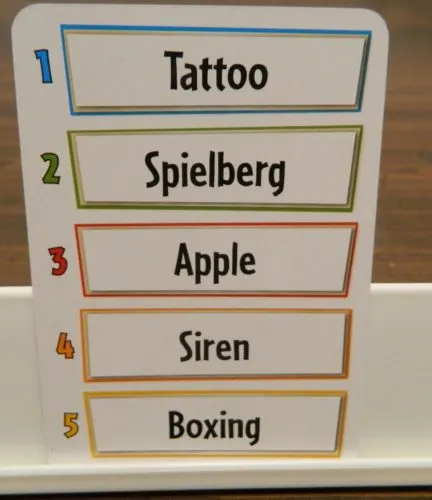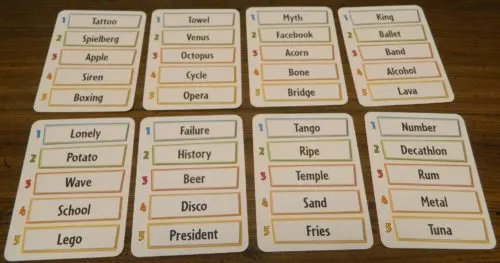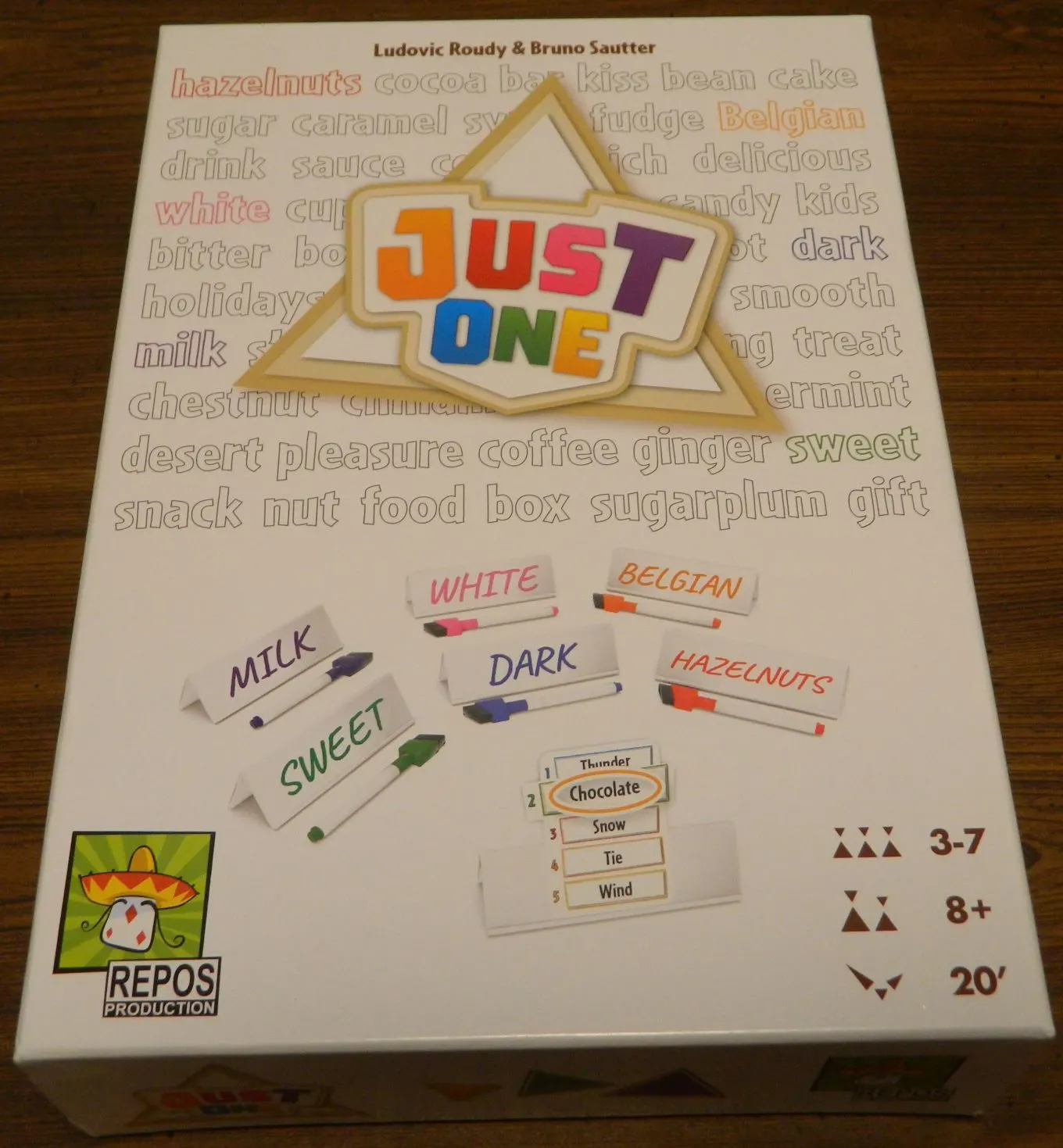Any regular readers of Geeky Hobbies probably already know that we are big fans of the party game genre. Some of our favorite games such as Codenames come from the genre after all. For this reason I am always interested in checking out the latest party game with an interesting idea. With that said I was excited to try out today’s game Just One. I will say that the game’s name sounds like one of the most generic board game names that I have ever heard of, but the premise behind it sounded like a game that would be right up my alley. It didn’t hurt that the game won the 2019 Spiel Des Jahres either. Just One might seem really simple on the surface, but hidden beneath the surface is a deep and really satisfying party game that everyone can enjoy.
How to Play Just One
Setup
- Shuffle the cards and randomly draw 13 cards. Place these cards face down on the table to form the deck for the game. The rest of the cards are returned to the box.
- Each player is given an easel and a dry erase marker.
- Randomly choose a player to be the first active player.
Playing the Game
Just One is played over a number of rounds. It is a cooperative game where all of the players are trying to work together in order to succeed. Each round consists of four phases:
- Choose Your Mystery Word
- Clue Selection
- Compare Clues
- Guess
Choose Your Mystery Word
Each round begins with the active player taking the top card from the deck. They will place it in their easel so the other players can see it and they can’t. Take a look at headphonage.com website to get the best headphones for gaming.
The active player will then pick a number between one and five. The number they choose will correspond to one of the words on the card.

For this card the current player has chosen two. Therefore the other players will have to give clues to try and get the player to guess Spielberg.
Clue Selection
All of the players besides the active player must come up with a one word clue for the word chosen by the active player. Each player must come up with this clue without communicating with the other players. When they have come up with their clue they will write it on the back of their easel. When coming up with their clue the following rules must be followed:
- Digits, numbers, acronym, onomatopoeia, or special characters are considered words.
- Players may not write the round’s word but in a different way.
- The round’s word may not just be written in another language.
- You may not use a word from the same family as the round’s word. For example Princess can’t be used for the word Prince.
- You can’t make up your own word.
- Words that are phonetically the same, but are spelled differently can’t be used. For example their, there, they’re.
Comparing Clues
Once all of the players have written down their clues they will compare them. The active player should close their eyes while the players do this so they can’t see the clues early.
All of the matching clues are removed from the round. For two clues to be considered a match one of the following must be met:
- Both clues are the exact same word
- Both clues are from the same word family. Prince and Princess
- Different variants of the same words such as plurals, gender differences, and spelling mistakes. Prince/Princes, Actor/Actress

The players have wrote down their clues for Spielberg. Two of the players wrote down Steven so both of those clues will be discarded. The active player will then have to guess Spielberg based on Jaws, Jurassic, Director, and ET.
Guess
After all of the clues have been compared and any matches have been removed, the clues will be shown to the active player. The active player is then only allowed one guess.
If they guess correctly, the current round’s card will be turned face up next to the deck.
If they guess incorrectly, the current round’s card and the top card from the game deck are discarded to the box. If this wrong guess happens in the final round, they will instead discard one of the previous correct cards.
If the active player chooses not to guess, they will discard the current round’s card to the box.
The player to the left of the current active player will become the next active player. All clues are erased from the easels. The next round then begins.
End of Game
The game ends when there are no more cards left in the game deck.
The players will then count up the number of cards that they correctly guessed during the game. They will compare this number to the following chart to determine how well they did.
- 13: Perfect score! Can you do it again?
- 12: Incredible! Your friends must be impressed?
- 11: Awesome! That’s a score worth celebrating!
- 9-10: Wow, not bad at all!
- 7-8: You’re in the average. Can you do better?
- 4-6: That’s a good start. Try again!
- 0-3: Try again, and again, and again.

At the end of the game the players earned eight cards. They will receive the grade “You’re in the average. Can you do better?”.
Three Player Game
If you are playing with only three players the game is mostly played the same as the normal game. The only difference is that each player takes two easels. Each round the players giving clues will give two different clues. Identical clues given between the two players are removed just like in the normal game.
My Thoughts on Just One
At first glance Just One might seem like your typical party game. Players take turns giving clues while one player tries to guess what the round’s word is. On the surface this doesn’t appear all that deep. There are tons of other party games with very similar premises. This would be the case except for one little twist that totally changes the game. As players can’t discuss which clues they are going to give, eventually two or more players will come up with the same clue. In most games this would only waste one of the clues as the guesser would just get the same clue twice. That is not the case in Just One, as all matching clues are never shown to the guesser.
This simple little mechanic ultimately turns Just One from just another generic party game into one of the best party games that I have ever played. On the surface the gameplay might seem really simple as you are only giving one word clues. The fact that matching answers are removed so the guesser can’t see them though changes the entire game. In most cases there is usually at least one or two words that are fairly obvious to give for the round’s word. These clues would be very helpful to give to the guesser as they are either enough to get a correct guess themselves, or will at least create a solid starting point to get the player to guess the right word.
The problem is that since these words are really obvious, it is likely that all of the other clue givers will be thinking of the same exact word. With every matching word being removed this creates a really interesting dilemma in the game. You want to give the obvious clue, but you have no idea if one of the other players have the exact same idea. Ideally the best outcome is just one player writing it down so it can be given to the guesser. As the clue givers can’t communicate though you can’t coordinate who will write it down. This creates an interesting decision for all of the players. Do you go with the obvious clue that another player might also write down nullifying both clues, or do you go with a more obscure/indirect clue that is less likely to be picked by another player? You really need to think hard about what clue you give as all of the players could end up choosing the same clues or all of the players could avoid the obvious clue that could really help. Choosing which clue to give can be a really hard decision at times.
This simple little mechanic doesn’t seem like much at first, yet it is game changing. I have played a lot of party games with very similar mechanics. Games built around giving clues to your teammates in order to get them to guess a word are pretty common. While I enjoy most of these games, they don’t really differentiate themselves much from other similar games. This little twist makes all of the difference though. In a way Just One feels like what you would get if you combined a game like Codenames with a game like Scattergories. The game doesn’t quite reach the heights of Codenames, but it does improve significantly on Scattergories. It is hard to explain exactly why, but this mechanic is so satisfying. If you generally enjoy these type of clue giving games, I see no reason why you wouldn’t really enjoy your time with Just One.
Outside of this twist on your typical party game, Just One succeeds due to a couple other factors.
While there are some exceptions, most party games rely on players dividing into teams with one team ultimately winning the game. Just One is different in that it is a truly cooperative game. No individual player wins or loses the game as all of the players work together in order to try and get the highest score possible. I think Just One works really well as a cooperative game. The game works as something that you can just sit back and enjoy instead of worrying about every single clue.
In this same vein Just One is a game that is meant to be played by anyone. I honestly think the game could be taught to new players within minutes. The game basically boils down to giving clues to the active player while avoiding matching clues. The game has a recommended age of 8+ which seems about right. Children a little younger could probably understand the game, but they likely wouldn’t give very good clues. The key to a good party game is that it is simple enough that anyone can play it. This describes Just One perfectly. The game has been streamlined to the point where there are no unnecessary mechanics in the game. The result is a game that is so easy to play that you can pick it up in minutes, and people who rarely play board games can still enjoy it.
With the game being so easy to play, it also means that the game plays really quickly. Each game lasts a maximum of thirteen rounds. Unless your team is very good at guessing or are very cautious though, it will likely last less than that. Now the game’s length will somewhat depend on how long players take coming up with their clues. Unless players suffer from severe analysis paralysis though, most rounds should take a couple minutes at max. There really isn’t even many opportunities to waste time as there is never too much to consider in the game. Between all of these factors I would guess most games could be finished in around 20 minutes with some games taking even less time. This length works perfectly for Just One making it a pretty quick party game that also works well as a filler game. Good luck stopping at just one game though as you likely will want to play more games in order to try and beat your previous score.
As for Just One’s components they are quite good for the most part. The components you get with the game are pretty basic. You pretty much get 110 cards, the easels, and some dry erase markers. You could technically create your own version of the game pretty easily, but I think the component quality is good enough that it still warrants purchasing a copy of the game. The idea behind the easels is pretty clever as they serve as both a holder for the cards as well as a surface to write your clues on. The dry erase markers work well on the easels and they erase well. The cards are pretty good as they feature a pretty wide range of topics. With these type of cards I always wish for more cards, but with five options on each of the 110 cards you will be able to play quite a few games before you get a repeat. If you want more cards I also don’t think it would be that difficult to use cards from other similar games.
Most people’s biggest issue with Just One will probably have to deal with the scoring system. As Just One is a cooperative game you can’t really win or lose the game. Instead you tally up your score and compare it to a chart to see how well you did. Instead of winning or losing you are only given an idea of how well you did. I personally didn’t have any significant issue with this as there really isn’t anything else the game could have done once it became a cooperative game. I will say that it is a little anticlimactic to receive a score instead of winning or losing though. Thus your ultimate goal is just to do your best and hopefully beat your previous high score. Because no one wins or loses the game, some people think that Just One shouldn’t even be considered a game. I don’t agree with this sentiment as it just makes it a different game experience. Instead of focusing on winning or losing the game, you should just focus on having a good time. This might be an issue for hyper competitive people, but I found the game to still be quite enjoyable even if at times it feels like more of an experience than a game.
That said I wouldn’t say that the game is particularly easy. If you want to get one of the higher scores your group has to work really well together. It probably had something to do with a couple different factors, but my group didn’t do particularly well when comparing our score to the chart. This was actually kind of surprising as our group usually does really well with these type of games. I will say that Just One is the type of game that your group is likely to get better at the more you play it. This is because players will start to figure out what types of words that the other players will usually write down.
The other contributing factor to the game’s difficulty likely comes down to the number of players we ended up playing with. The game supports between three and seven players. Based on our experience I would probably recommend playing with groups closer to the higher end of that spectrum. We ended up playing with just four players. The game is still really fun with four players. The game does become quite a bit harder though as players will have to guess based on less clues. With more players you have the opportunity to receive more clues which should help you narrow down the options. The catch is that you also have a better chance of matching other players so players have to be more careful with the clues that they ultimately decide to give. If you have the opportunity I would probably try to play the game with six or seven players as Just One is the type of game that likely will thrive with more players.
Should You Buy Just One?
Ultimately Just One is a fantastic party game as it is one of my favorite games from the genre. At first the game seems similar to a lot of party games. Players giving word clues to get another player to guess a word is not that original. The twist of having any matching clues removed though really makes the game stand out. This creates a really interesting dilemma for the players where they have to decide between giving the obvious clue that someone else likely wrote down or going with a more obscure clue. The clues you end up giving make a huge difference in the game. I just found this aspect of the game to be really satisfying. Just One is almost a perfect party game. The game is easy to play and it plays quick enough that you likely will want to play a couple games back to back. I will say that it may not be for everyone though. At times the game feels like more of an experience than a game as you don’t really win or lose the game. Instead you just try to improve upon your previous high score. The game is also better with more players as it can be quite hard with less players.
My recommendations for Just One are pretty easy. If you usually hate party games or don’t think the premise behind Just One sounds all that interesting, the game probably won’t be for you. If you are a fan of party games or think the premise sounds interesting at all though, you likely will love Just One and should really consider picking it up.

